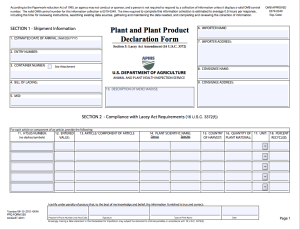The Lacey Act regulates imports of wood and wood products, but because of the way it has been implemented and the way it must be filed, there can be compliance gulfs created between Customs entry submission and Lacey Act Declaration submission.
In this first part of a multi-part series, we want to provide background on the history of the Lacey Act and how importers must comply with its requirements and what Customs brokers do when filing entries for merchandise that is covered by the Lacey Act’s regulations.
History:
 First enacted in 1900 to combat the impact of hunting to supply commercial markets, interstate shipment of unlawfully killed game and the killing of birds for the feather trade (remember, this was 1900!), an amendment to the Act was passed by Congress on May 22, 2008. The act was expanded to cover products derived from illegal harvested plants, including timber, and requires a new declaration for plant products. A great FAQ document is available here.
First enacted in 1900 to combat the impact of hunting to supply commercial markets, interstate shipment of unlawfully killed game and the killing of birds for the feather trade (remember, this was 1900!), an amendment to the Act was passed by Congress on May 22, 2008. The act was expanded to cover products derived from illegal harvested plants, including timber, and requires a new declaration for plant products. A great FAQ document is available here.
The two agencies charged with administering the Act’s requirements are APHIS (for the plant provisions) and Fish and Wildlife (naturally, for the animal provisions).
The Act was named after Congressman John Lacey of Iowa and signed into law by President McKinley.
Responsibility:
The U.S. Importer of Record (as defined by Customs), is legally responsible for a shipment, its contents, paperwork and declarations to the government at the time of importation. If an importer is using a Customs broker, that broker can file the declaration on the importer’s behalf.
 The Act carries two primary requirements; the legality requirement and the declaration requirement. The legality requirement means making sure that the goods which are being imported meet the admissibility criteria regarding harvesting, legality of transactions and compliance with international treaties or conventions such as CITES. The declaration requirement involves the filing of the PPQ Form 505. This declaration can be filed as part of the ABI transmission to Customs, or the form can be completed and submitted to CBP with the entry. If the entry is paperless, however, the form has to be mailed to APHIS with the entry number to connect the transactions.
The Act carries two primary requirements; the legality requirement and the declaration requirement. The legality requirement means making sure that the goods which are being imported meet the admissibility criteria regarding harvesting, legality of transactions and compliance with international treaties or conventions such as CITES. The declaration requirement involves the filing of the PPQ Form 505. This declaration can be filed as part of the ABI transmission to Customs, or the form can be completed and submitted to CBP with the entry. If the entry is paperless, however, the form has to be mailed to APHIS with the entry number to connect the transactions.
Part II of the series will focus on the implementation and consequences of non-compliance.


Comments are closed.